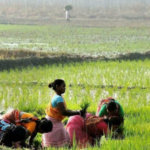What’s in this Article?
- Table of Contents
- Why in the news (In Short)?
- Shiv Khera (Petitioner)
- In Depth Analysis
- About NOTA (None Of The Above)
- When was it first used?
- How does a person cast a NOTA vote?
- Does it have any impact on the results?
- Conclusion
Why in the news?
- In Short
- The Supreme Court has issued a notice to the Election Commission of India (ECI) on a plea calling for fresh elections if the ’none of the above’ (NOTA) option gets maximum votes.
- A petition was filed by writer and motivational speaker Shiv Khera seeking directions to declare polls in a constituency “null and void” where most electors choose NOTA.
- The plea also sought to bar candidates, who lost to NOTA, from contesting the elections for five years. A three-judge bench, led by Chief Justice of India (CJI) DY Chandrachud, on Friday (26 April) asked the poll body to analyse the rules around NOTA, reported NDTV.
Shiv Khera (Petitioner)
- Shiv Khera is an Indian author, activist and motivational speaker, best known for his book, You Can Win.
- Khera was born in a business-oriented family (Dhanbad, Jharkhand, India) that operated coal mines, which were eventually nationalized by the Indian government.
- In his early years, he worked as a car washer, a life insurance agent, and a franchise operator before becoming a motivational speaker.
- While working in Toronto, he was inspired by a lecture delivered by Norman Vincent Peale and claims to follow Peale’s motivational teachings.
- He launched a movement against caste-based reservation in India, founded an organization called Country First Foundation.
In Depth
- Shiv Khera, in his petition, also requested the establishment of regulations stipulating that candidates receiving fewer votes than NOTA would be prohibited from running in any elections for five years.
- Additionally, he proposed the need for clear and effective promotion of NOTA as a “Fictional Candidate.”
- Senior Advocate Gopal Sankarnarayan, representing Shiv Khera, informed the Supreme Court about the recent developments in the Surat Lok Sabha election.
- He explained that in Surat, due to the absence of any other candidates, all voters were left with only one option.
- Shiv Khera, through his representative Sheeta Mazumdar, filed a petition requesting the Supreme Court to instruct the Election Commission of India to establish guidelines or regulations ensuring consistent application of the NOTA (None of the Above) voting option, along with consequences for candidates who fail to surpass NOTA votes.
- The NOTA option was introduced by the Election Commission and various State Election Commissions in November 2013, both in national and local body elections.
- The petitioner highlighted that a notable impact of NOTA was observed in Maharashtra, Haryana, Delhi, and Puducherry. In these regions, the State Election Commissions (SEC) introduced a crucial change: if NOTA secured the most votes in any election, a mandatory re-poll would be conducted.
- This marked a significant alteration in the electoral process since NOTA’s introduction.
- The notifications issued by the respective State Election Commissions treated NOTA as a hypothetical candidate and explicitly stated that declaring the candidate with the second highest votes as the winner (in case NOTA received the most votes) goes against the fundamental purpose of NOTA.
- The petition further added that since 2013, the implementation of NOTA has not fulfilled the very purpose that it was supposed to.
- The petition contends that the introduction of NOTA by the Supreme Court aimed to boost voter engagement, yet this objective remains unmet. To achieve this, the petitioner urges the Election Commission at both state and central levels to empower NOTA, following the example set by Maharashtra, Delhi, Puducherry, and Haryana.
- The inclusion of NOTA in Electronic Voting Machines stems from the voter’s “right to reject” within our electoral framework.
- Prior to India, 13 other nations embraced negative voting or the right to reject, the plea highlights.
- The petition further argues that the Election Commission of India has overlooked NOTA’s significance as a viable option in democratic governance. NOTA isn’t merely a choice to abstain from voting; it represents a valid selection, integral to the democratic process.
- The petition additionally asserted that while the Supreme Court initially embraced the idealistic notion of incorporating NOTA (None of the Above) into the electoral framework, it is the State Election Commissions, empowered by the Constitution of India, 1950, that have translated this idealism into practice.
- Originating from the Panchayat and Municipal elections in four states, this initiative should be uniformly applied across all levels, argued the petitioner.
- According to the petition, the essence of NOTA lies in pressuring political parties to field more qualified candidates.
- It highlights situations where a majority of candidates in a constituency have pending criminal cases, leaving voters with limited options. In such scenarios, NOTA serves as a significant tool in the hands of the electorate.
About NOTA (None of the Above)
- It is a ballot option provided in the elections to the Indian voter.
- It is the option which enables the voter to officially register a vote of rejection for all candidates who are contesting.
- If a voter chooses to press NOTA, it indicates that the voter has not chosen to vote for any of the parties.
- Objective: To enable electors who do not wish to vote for any of the candidates to exercise their right to reject without violation of the secrecy of their decision.
When was it first used?
- NOTA was used for the first time in the 2013 Assembly elections in five states – Chhattisgarh, Mizoram, Rajasthan, Delhi, and Madhya Pradesh – and later in the 2014 General Elections.
- It was introduced into the electoral process following the 2013 Supreme Court directive in the PUCL versus Union of India case.
How does a person cast a NOTA vote?
- The NOTA option in the Electronic Voting Machines (EVMs) is given at the bottom of the candidates’ list.
- Earlier, in order to cast a negative ballot, a voter had to inform the presiding officer at the polling booth.
- Now the voter has just to press the NOTA option on the EVM.
Does it have any impact on the results?
- NOTA has no electoral value in the Indian system.
- Even if the maximum votes are given in favour of NOTA, the candidate with the largest number of votes, which could theoretically even be just one, will still be declared the winner.
Conclusion
- This is about what NOTA would be provided as a choice to the voters of Asian nations in most elections since
- The vote doesn’t hold any electoral value: albeit a majority of votes square measure solid, the candidate with the most important vote share will decide the winner.
- By representing a preference for none of the higher than, a national will select to not vote for any candidates World Health Organization square measure holding the elections.
- The NOTA possibility was 1st utilised in the 2013 assembly elections control in four states (Chhattisgarh, Mizoram, Rajasthan and Madhya Pradesh) and the Union Territory of the urban centre.
Disclaimer: The article may contain information pertaining to prior academic years; for further information, visit the exam’s “official or concerned website“.








